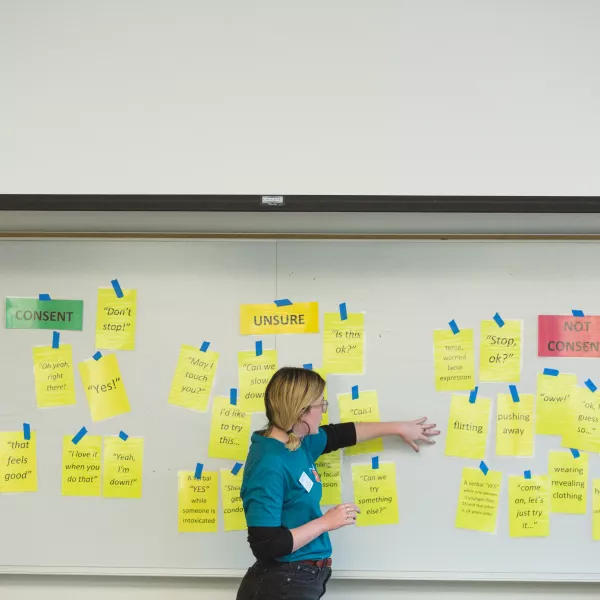As a novelist, I take seriously the responsibility of showing the “truth inside the lie,” as Stephen King once put it. When I decided to write my 2017 novel, “It Happens All the Time,” I drew from my own emotional experiences of being a survivor of sexual assault, but also chose to include the perpetrator’s point of view, with the specific intent of depicting how a seemingly “good” man crosses the line and commits an unthinkable act. I took this approach not to excuse a rapist’s behavior, but rather to spark a conversation about why, as a society, we focus on educating our girls to protect themselves from getting raped, but rarely do enough to teach our boys how to ask for and identify consent.
Many people, it turns out, weren’t ready for this conversation. When I asked parents on social media whether they had spoken to their sons about the intricate nature of sexual consent, much of the conversation turned to the topic of protecting boys. “Boys get raped, too!” the chorus called out. (This is true, of course. But women are sexually assaulted at a much higher rate than men: 90 percent of all adult rape victims are female).
Initially, it seemed the outcry was an all-too-common, knee-jerk response to shift the conversation away from holding men responsible for their errant behavior. But I soon realized that this fervent reaction was rooted in a much deeper problem: our general inability to find the proper context in which to have a balanced discussion about sexual assault. I started wondering if educating our young people about consent as an antidote to sexual violence is enough.
The trouble with relying only upon consent to determine if a person wants to have sex with you is that it doesn’t address the silent, highly complex circumstances that often contribute to the misunderstanding or miscommunication of whether or not a person legitimately wants to proceed with sexual activity.
“No means no” and “Yes means yes” are inadequate slogans.
What if a person says yes, at first, but then changes their mind and communicates the “no” they feel by becoming unresponsive? What if the person they are with doesn’t notice this, or even worse, doesn’t care? What if a young person submits because he or she has been threatened with physical violence, or has suffered sexual abuse in the past where consenting to an attacker’s demands was the only way to survive? Consent given by a person merely submitting to sexual interaction is not consent.
I’m not saying that we should stop teaching the importance of getting consent from a potential sexual partner. I’m saying we need to challenge the notion that girls are always responsible for giving consent and boys are always demanding sex. We should hold all young people responsible in the decision-making process and teach them to look for more than consent—they should look for enthusiasm, an emotion hard to mistake for anything else in any circumstance.
The difference between enthusiasm and mere submission can be taught long before our children are ready to learn about the mechanics of sex. We can help them understand that a rough game of dodgeball is only a game if everyone is enjoying it, and ceases being fun if someone is being singled-out, teased or hurt. We can teach our children how to not bully others into doing things they don’t want to do, and how to recognize and interpret non-verbal communication.
I had to do this with my own son, who, around age 6, developed a habit of unexpectedly invading others’ personal space. He would stand too close for too long, and tenderly stroke peoples’
arms or faces without permission. We were a loving, expressive family, and he was a sweet, sensitive boy, so it wasn’t the showing of affection that concerned us. It was the slightly aggressive insistence of his behavior that made us uncomfortable, and we worried if left unchecked, this tendency would grow into a feeling of entitlement to others’ physical affection. We had to explain to him time and again that showing love through touch was a wonderful thing, but it was important to ask for a person’s permission, first.
We worked with him to pay attention to things like facial expressions as tools that would help him decide whether it was a good time to initiate affection. We talked about how when a person stiffens up when he hugged them, it meant they didn’t want to be touched and that he should let them go, immediately. We taught him it was possible for a person to say they wanted a hug, or even initiate one themselves, but then change their mind in the middle of it. It wasn’t until years later, when he was 14 and we had a frank discussion about consent that I realized in teaching him about how platonic relationships work—respecting others’ boundaries and feelings, expressing physical affection only with permission, reading subtle body language cues—we’d already laid the internal groundwork for him to understand the more complicated dynamics of sexually charged situations.
Without having specifically set out to do so, we taught him the basic tenets of emotional intelligence—loosely defined as the ability to recognize emotions and their impact, in yourself and others. Having empathy, being aware of another person’s emotional state, (which can be communicated in a hundred different ways other than verbally), is the element missing from the transactional, cut-and-dry idea of obtaining consent. It’s what’s missing from every situation where a young man who would never consider himself a rapist ignores his victim’s tense muscles and hot, salty tears as he climbs on top of her and takes what he wants from her body. It’s what was missing the night a boy I knew and trusted grabbed me by the back of the neck and sent me home an hour later barely able to swallow.
We can’t wait until our children are old enough to understand the complexities of human sexuality to teach them about consent as a way to prevent sexual assault. By then, the 6-year-old who disregards another child’s feelings by bullying them into playing a rough-and-tumble game has become the teenager who threatens, manipulates, and cajoles his dates into submitting to sex against their will.
Imagine, instead, a world where teaching a child how to have empathy is as important a part of a school’s curriculum as learning to read. Imagine that interpreting and respecting body language and other emotional cues comes as naturally to us all as taking a breath. Taking steps toward living in a world like this might not completely eradicate the occurrence of sexual assault, but it’s a start. We need to do a better job of addressing the root causes of this epidemic our country faces, and focus on the kind of early education and intervention that will actually make a difference in the long run. Until we do, more men will become rapists, and more women will continue saying, “Me, too.”



